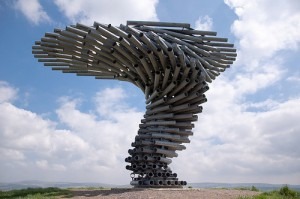 All art, according to Walter Pater’s famous words “constantly aspires towards the condition of music.” Since architecture and music are based on rhythm, proportion and harmony, they do share a clear cultural lineage. The search for the visual equivalent of musical themes has long inspired artists throughout the ages to create structures akin to “frozen music.” Music, of course, is experienced over time while architecture grasped as a spatial whole. As such, ceremonial structures—anything ranging from churches to concert halls—have been constructed to heighten the senses and elicit an emotional involvement and response. But what happens when the architectural structure is not only in the service of music but actively involved in making of music itself? The highly creative answer to this question can be found in a wind-powered sound sculpture found in the district of East Lancashire, England.
All art, according to Walter Pater’s famous words “constantly aspires towards the condition of music.” Since architecture and music are based on rhythm, proportion and harmony, they do share a clear cultural lineage. The search for the visual equivalent of musical themes has long inspired artists throughout the ages to create structures akin to “frozen music.” Music, of course, is experienced over time while architecture grasped as a spatial whole. As such, ceremonial structures—anything ranging from churches to concert halls—have been constructed to heighten the senses and elicit an emotional involvement and response. But what happens when the architectural structure is not only in the service of music but actively involved in making of music itself? The highly creative answer to this question can be found in a wind-powered sound sculpture found in the district of East Lancashire, England.
Constructed in the form of a tree bending against the endless winds of the Lancashire hills, the “Singing-Ringing Tree” is the brainchild of award-winning architects Mike Tonkin and Anna Liu. Tonkin had studied at the Leeds School of Architecture and the Royal College of Art before traveling extensively throughout Asia. He eventually settled in Hong Kong and his design company undertook projects in Indonesia, Thailand and Hong Kong. Liu, on the other hand, came from a North American background, working in New York and Los Angeles before completing her degree at Columbia University. The architectural duo hooked up in Hong Kong with a view of dismantling current mythology and establishing their own. Following the return of Hong Kong to China in 1997, they moved to England and set up shop there.
Singing- Ringing Tree
For the “Singing-Ringing Tree” project, swirls of galvanized steel pipes are ingeniously twisted into a 3-meter tall structure. Some of the pipes are used for primarily structural and aesthetic effect, while others harness the energy of the wind to produce an almost ethereal choral sound that covers several octaves. Simultaneously discordant and melancholy, the haunting and melodious hum is the result of careful tuning. Acousticians tuned the tree according to individual pipe length, and by providing “finger holes” on the underside of the tubes. The acoustic properties were specifically designed not to disturb surrounding wildlife or gracing domestic animals. And by all accounts, the sheep really like the eerie musical background to their daily gracing!
The “Singing-Ringing Tree” was completed in 2006, and received the National award of the Royal Institute of British Architects in 2007. The tree is actually part of an architectural project called “Panopticons” that features four 21st-century installations scattered throughout Eastern Lancashire. Besides the Tree of Burnley, we find the Atom of Pendle, the Colourfield in Blackpool and the Haslingden Halo. The project has become a much visited tourist attraction over the last couple of years. In particular, the “Singing-Ringing Tree” has spawned a storytelling competition and the Duet No. 1 for Synthesizer and Singing Ringing Tree by John Kesson, which explores the “synesthetic relationship between auditory and optical landscapes.”




